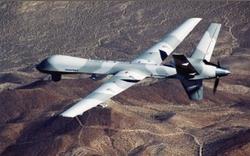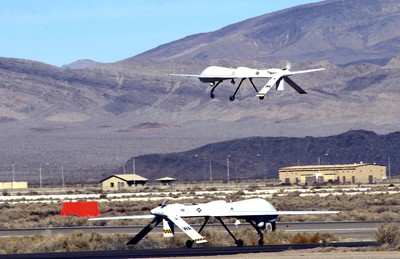UAVs Handling More And More Dirty Work
 A significant unmanned aerial
vehicle warfighting milestone was reached more than two years ahead
of schedule May 1, with the beginning of the 24th MQ-1 Predator
combat air patrol in the global war on terror, Air Force officials
announced this week.
A significant unmanned aerial
vehicle warfighting milestone was reached more than two years ahead
of schedule May 1, with the beginning of the 24th MQ-1 Predator
combat air patrol in the global war on terror, Air Force officials
announced this week.
This CAP doubles the around-the-clock Predator capability of
last year, two years ahead of the Defense Department's goal of 2010
for 21 Predator CAPs, officials said.
Predators now supply more than 13,400 hours of full-motion video
to ground forces every month while conducting armed overwatch,
force protection and precision air-to-surface engagements with the
AGM-114 Hellfire missile.
"The Predator teams have just been doing unbelievable work down
there [in the International Zone], and in Baghdad as well," Army
Gen. David H. Petraeus, commander of Multinational Force Iraq, said
recently. "And I think there's some path-breaking work on going
here."
Sustaining one CAP 24 hours a day, seven days a week, 365 days a
year typically calls for four aircraft, but for surge operations,
the Air Force now maintains 24 continuous CAPs with the total fleet
of 76 combat aircraft.
Predator missions are launched by crews at sites in US Central
Command's area of responsibility while flown by crews at various
locations in the United States. This concept of operations, called
remote split operations, allows greater effectiveness in supplying
more full-motion video directly to warfighters engaged in combat,
officials said. This model of operations nearly triples sustainable
combat capability by maximizing the number of available crews and
aircraft engaged in combat operations in the global war on terror,
Air Force officials said.
Prior to the innovation of remote split operations in Operation
Iraqi Freedom, the Air Force used a traditional unit-deployment
model developed in the 1990s. The traditional model of rotating
units through the theater limited the Air Force to committing only
about 30 percent of its Predator forces to combat. Under this
remote model, the Air Force commits 85 percent of its aircraft to
combat operations.
And just as split operations allow more aircraft in combat,
flying the missions from the continental United States reduces the
number of Americans deployed to Iraq and Afghanistan to conduct
these missions, officials said, noting that the smaller forward
presence reduces American exposure to enemy actions and allows the
Air Force to project power without projecting vulnerability.

The Air Force acceleration of Predator capability to combat was
made possible by increased production and delivery of Predator
aircraft and several personnel actions, including freezing Predator
assignments and reassigning pilots from other aircraft and duties
to meet the growing demand for full-motion video, officials said.
The Air National Guard also has accelerated its Predator commitment
in five states, operating six CAPs.
The Air Force plans to expand Predator training by standing up a
second Predator training squadron and establish a Predator weapons
instructor course in early 2009. This action is necessary to lay
the foundation to further increase and enhance joint warfighting
capability, officials said.
 ANN's Daily Aero-Term (05.17.24): Very High Frequency
ANN's Daily Aero-Term (05.17.24): Very High Frequency ANN's Daily Aero-Linx (05.17.24)
ANN's Daily Aero-Linx (05.17.24) ANN FAQ: Submit a News Story!
ANN FAQ: Submit a News Story! Classic Aero-TV: ANN Visits Wings Over The Rockies Exploration Of Flight
Classic Aero-TV: ANN Visits Wings Over The Rockies Exploration Of Flight Airborne Affordable Flyers 05.16.24: PRA Runway, Wag-Aero Sold, Young Eagles
Airborne Affordable Flyers 05.16.24: PRA Runway, Wag-Aero Sold, Young Eagles




